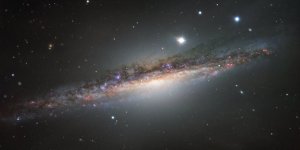| News / Space News |
Moon Data Sheds Light on Earth’s Asteroid Impact History
The number of asteroid impacts to the Moon and Earth increased by two to three times starting around 290 million years ago.

Craters in Mare Tranquillitatis. Image credit: NASA/GSFC/Arizona State University
Researchers could tell by creating the first comprehensive timeline of large craters on the Moon formed in the last billion years by using images and thermal data collected by NASA’s Lunar Reconnaissance Orbiter (LRO). When the scientists compared those to the timeline of Earth’s craters, they found the two bodies had recorded the same history of asteroid bombardment—one that contradicts theories about Earth’s impact rate.
For decades, scientists have tried to understand the rate that asteroids hit the Earth by carefully studying impact craters on continents and by using radiometric dating of the rocks around them to determine the ages of the largest, and thus most intact, ones.
The problem is that many experts assumed that early Earth craters have been worn away by wind, storms, and other geologic processes. This idea explained why Earth has fewer older craters than expected compared to other bodies in the solar system, but it made it difficult to find an accurate impact rate and to determine whether it had changed over time.
A way to sidestep this problem is to examine the Moon. Earth and the Moon are hit in the same proportions over time. In general, because of its larger size and higher gravity, about twenty asteroids strike Earth for every one that strikes the Moon, though large impacts on either body are rare.
But even though large lunar craters have experienced little erosion over billions of years, and thus offer scientists a valuable record, there was no way to determine their ages until the Lunar Reconnaissance Orbiter started circling the Moon a decade ago and studying its surface.
LRO's thermal radiometer, called Diviner, has taught scientists how much heat is radiating off the Moon’s surface, a critical factor in determining crater ages. By looking at this radiated heat during the lunar night, scientists can calculate how much of the surface is covered by large, warm rocks, versus cooler, fine-grained regolith, also known as lunar soil.
Large craters formed by asteroid impacts in the last billion years are covered by boulders and rocks, while older craters have few rocks, Diviner data showed. This happens because impacts excavate lunar boulders that are ground into soil over tens to hundreds of millions of years by a constant rain of tiny meteorites.
First, the team discovered that the rate of large crater formation on the Moon has been two to three times higher over approximately the last 290 million years than it had been over the previous 700 million years.
The reason for this jump in the impact rate is unknown. It might be related to large collisions taking place more than 300 million years ago in the main asteroid belt between the orbits of Mars and Jupiter, the researchers noted. Such events can create debris that can reach the inner solar system. (NASA)
YOU MAY ALSO LIKE

